Directions (1-5): Study the given information carefully and answer the questions that follow:
Eight friends J, K, L, M, N, O, P and Q are sitting in a linear row. Some of them face towards south direction and some of them face towards north direction. No two friends sitting together according to the alphabetical order (i.e., A does not sit immediate neighbor of B and B does not sit immediate neighbor of A).
M sits 3rd to the right of J. O and M face the same direction as K is facing. The number of persons sitting to the right of P is equal to the number of persons sitting on the right of M. J sits one of the extreme ends of row. L and N are immediate neighbors but both face opposite directions with respect to each other. Q sits 4th to the right of L. L does not sits on the left of P. K sits on the left of L but does not face the same direction as J. Q faces the same direction as J and P are facing. N does not face south direction.
Q1. Who among the following sits 2nd to the right of L?
(a) J
(b) P
(c) K
(d) M
(e) Q
Q2. How many persons face south direction?
(a) Four
(b) Three
(c) One
(d) Two
(e) More than Four
Q3. Who among the following sits on the immediate left of J?
(a) K
(b) M
(c) N
(d) Q
(e) No one
Q4. Who among the following sits on the immediate left of K?
(a) L
(b) P
(c) J
(d) Q
(e) No one
Q5. J is related to O, in the same way M is related to L then who among the following follow same pattern N is related to?
(a) P
(b) M
(c) Q
(d) K
(e) J
Directions (6-10): In each of the questions below some statements are given followed by some Conclusions. You have to take the given statements to be true even, if they seem to be at variance from commonly known facts. Read all the conclusions and then decide which of the given conclusions logically follows from the given statements disregarding commonly known facts.
(a) If only conclusion I follows.
(b) If only conclusion II follows.
(c) If either conclusion I or II follows.
(d) If neither conclusion I nor II follows.
(e) If both conclusions I and II follow.
Q6. Statements: Some Ram are Rom
No Rom is bag
All bag are Bottle
Conclusion: I: All rom can never be bottle
II: Some bottle are not Rom
Q7. Statements: All Desk are table
Some table are wood
All room are wood
Conclusion: I: Some room are table
II: No table is room
Q8. Statements: No Pencil are pen
No charger are mobile
Some pen are Charger
Conclusions: I. Some mobile can be pen
II. Some pencil is mobile
Q9. Statements: Only a few ratio is fraction
Some fraction are Review
All review are tool
Conclusions: I. Some fraction are tool
II. Some review are ratio is a possibility
Q10. Statements: Some grapes are green
All green are black
Only a few black are Pink
Conclusions: I: Some grapes are black
II: All black are pink is a possibility
Directions (11-13): Study the information carefully and answer the questions given below.
Six persons A, B, C, D, E and F sit around circular table in such a way that all of them face towards center. Each of them has different age i.e., 13, 17, 26, 39, 42 and 52 but not necessary in same order.
D’s age is prime number and sits second to the right of B. The one who is 26 years old is immediate neighbor of D. E sits opposite to the one who is 13 years old. The one who is 52 years old sits immediate right of D. The one who is 39 years old sits immediate left of the one who is 42 years old. E is not 42 years old. F sits second to the right of A. F is neither 26 nor 52years old.
Q11. Who among the following is 52yr old?
(a) D
(b) E
(c) A
(d) F
(e) None of these
Q12. Who among the following sits opposite to C?
(a) D
(b) The one who is 13yr old
(c) F
(d) The one who is 26yr old
(e) B
Q13. Who among the following sits immediate right of the one who is 13yr old?
(a) D
(b) F
(c) E
(d) B
(e) C
Q14. If in the number 9365714873, all the digits are arranged in increasing order from left to right in such a way first prime numbers then odd numbers and last even numbers are arranged. After this arrangement 2 is subtracted to last four digits and 2 is added in the rest of the digits after that subtract 1 from each of the digits then how many digits remain at the same position in the new arrangement?
(a) Two
(b) Three
(c) None
(d) One
(e) Four
Q15. If D is father of P, who married to B, who is mother of S, who married to M, who is daughter of H then how is S related to D?
(a) Grandfather
(b) Father
(c) Granddaughter
(d) Grandson
(e) None of these
Solutions




S14. Ans.(d)
Sol. Original number- 9365714873
Obtained number- 4468826135






 GA Capsule for SBI Clerk Mains 2025, Dow...
GA Capsule for SBI Clerk Mains 2025, Dow...
 The Hindu Review October 2022: Download ...
The Hindu Review October 2022: Download ...
 Without These Documents, Your Bank Exam ...
Without These Documents, Your Bank Exam ...


